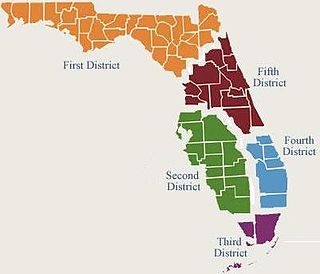In the United States, a state supreme court is the highest court in the state judiciary of a U.S. state. On matters of state law, the judgment of a state supreme court is considered final and binding in both state and federal courts.

The United States courts of appeals are the intermediate appellate courts of the United States federal judiciary. The courts of appeals are divided into 11 numbered circuits that cover geographic areas of the United States and hear appeals from the U.S. district courts within their borders, the District of Columbia Circuit, which covers only Washington, D.C., and the Federal Circuit, which hears appeals from federal courts across the United States in cases involving certain specialized areas of law. The courts of appeals also hear appeals from some administrative agency decisions and rulemaking, with by far the largest share of these cases heard by the D.C. Circuit. Appeals from decisions of the courts of appeals can be taken to the U.S. Supreme Court.

A trial court or court of first instance is a court having original jurisdiction, in which trials take place. Appeals from the decisions of trial courts are usually made by higher courts with the power of appellate review. Most appellate courts do not have the authority to hear testimony or take evidence, but instead rule solely on matters of law.
In law, an en banc session is a session in which a case is heard before all the judges of a court rather than by one judge or a smaller panel of judges.

The United States Court of Appeals for the Ninth Circuit is a federal court of appeals that has appellate jurisdiction over the U.S. district courts in the following federal judicial districts:
Circuit courts are court systems in several common law jurisdictions. The core concept of circuit courts requires judges to travel to different locales to ensure wide visibility and understanding of cases in a region. More generally, the term may also refer to a court that merely holds trials and other proceedings at a series of multiple locations in some kind of rotation.

The Court of Appeals of Maryland is the highest court of the U.S. state of Maryland. The court, which is composed of one chief judge and six associate judges, meets in the Robert C. Murphy Courts of Appeal Building in the state capital, Annapolis. The term of the Court begins the second Monday of September. The Court is unique among American courts in that the judges wear red robes. The Maryland Court of Appeals joins the New York Court of Appeals in being the only two state highest courts to bear the name "Court of Appeals" rather than "Supreme Court".

The District of Columbia Court of Appeals is the highest court of the District of Columbia, in the United States. Established in 1970, it is equivalent to a state supreme court, except that its authority is derived from the United States Congress rather than from the inherent sovereignty of the states. The court is located in the former District of Columbia City Hall building at Judiciary Square. The D.C. Court of Appeals should not be confused with the District's federal appellate court, the United States Court of Appeals for the District of Columbia Circuit. The D.C. Court of Appeals and the Superior Court of the District of Columbia comprise the District's local court system.

The district courts of appeal (DCAs) are the intermediate appellate courts of the Florida state court system. There are five DCAs:

The Supreme Court of Missouri is the highest court in the state of Missouri. It was established in 1820 and is located at 207 West High Street in Jefferson City, Missouri. Missouri voters have approved changes in the state's constitution to give the Supreme Court exclusive jurisdiction – the sole legal power to hear – over five types of cases on appeal. Pursuant to Article V, Section 3 of the Missouri Constitution, these cases involve:
The Court of Appeals of Virginia, established January 1, 1985, is an intermediate appellate court of 17 judges that hears appeals from decisions of Virginia's circuit courts and the Virginia Workers' Compensation Commission. The Court sits in panels of at least three judges, and sometimes hears cases en banc. Appeals from the Court of Appeals go to the Supreme Court of Virginia.

Danny Julián Boggs is an American attorney and a Senior United States Circuit Judge of the United States Court of Appeals for the Sixth Circuit. He was appointed to the court in 1986 and served as its Chief Judge from September 2003 to August 2009. Boggs was on the short list of President George W. Bush's candidates for the U.S. Supreme Court.

The California Courts of Appeal are the state intermediate appellate courts in the U.S. state of California. The state is geographically divided along county lines into six appellate districts. The Courts of Appeal form the largest state-level intermediate appellate court system in the United States, with 106 justices.
The Court of Appeal for Saskatchewan (SKCA) is a Canadian appellate court.
A Bankruptcy Appellate Panel is authorized by 28 U.S.C. § 158(b) to hear, with the consent of all parties, appeals from the decisions of the United States bankruptcy courts in their district that otherwise would be heard by district courts, but only in those districts in which the district judges authorize appeals to BAPs. BAPs typically sit as three-judge panels composed of bankruptcy judges appointed from the circuit's districts, with the restriction that no judge may participate in an appeal arising from that judge's own district.
The Georgia Court of Appeals is the intermediate-level appellate court for the U.S. state of Georgia.

The Colorado Court of Appeals is the intermediate-level appellate court for the state of Colorado. It was initially established by statute in 1891 and was reestablished in its current form in 1970 by the Colorado General Assembly under Article VI, Section 1 of the Constitution of Colorado.

The South Carolina Court of Appeals is the intermediate-level appellate court for the state of South Carolina.

Courts of Michigan include:

In law, an appeal is the process in which cases are reviewed by a higher authority, where parties request a formal change to an official decision. Appeals function both as a process for error correction as well as a process of clarifying and interpreting law. Although appellate courts have existed for thousands of years, common law countries did not incorporate an affirmative right to appeal into their jurisprudence until the 19th century.












